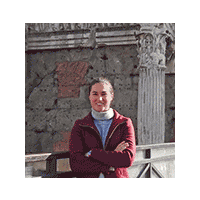
Margaret M. Andrews is an archaeologist specializing in ancient cities and urbanism. Her research focuses on Roman sites and the city of Rome itself, and, more specifically, the physical and social changes that these settlements experienced over the longue durée. She is also interested in the creation and long-term transformation of ideological and religious landscapes in cities and the active role of the everyday residents in shaping them.
Meg received an A.B. in Classics from Princeton University in 2005 and a Ph.D. in the Art and Archaeology of the Mediterranean World from the University of Pennsylvania in 2015. From 2011-2012, she was a Rome Prize Fellow in Ancient Studies at the American Academy in Rome. Her dissertation examined the physical, social, and religious evolution of the landscape of the ancient Subura valley in Rome from the Republican period through the Early Middle Ages (ca. 500 BCE-850 CE). It analyzed how the topographical development of the region both shaped and was shaped by the broader shifting social, political, and economic dynamics of that timeframe and demonstrated how an ideology of feminine virtue as an critical civic component pervaded the landscape in both the Roman and Christian periods.
Meg has excavated at various sites in Italy and Greece. Most notably, from 2007-2010, she supervised excavations at the imperial villa and medieval monastery at Villamagna, south of Rome, for the Villa Magna Project and thereafter co-edited the final publication for the site. She has also published several aspects of her fieldwork in Rome, including two articles in the American Journal of Archaeology. She is currently preparing a monograph on the archaeology and social history of the Subura in antiquity.
